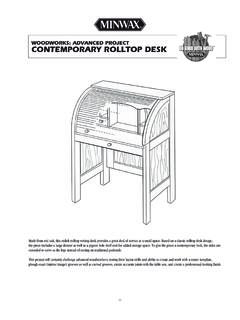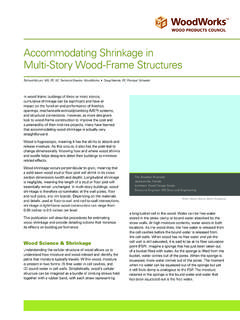Transcription of Strip Building Notes for Canoes and Rowboats
1 1 2010 Newfound woodworks , Inc. Strip Building Notes for Canoes and Rowboats Revised 10/10 The Newfound woodworks , Inc. 67 Danforth Brook Road, Bristol, NH 03222 603-744-6872 E-mail: 2 2010 Newfound woodworks , Inc. This is a collection of the techniques we have used successfully in Building cedar Strip /epoxy Canoes . We have created this as a supplement to the books we sell. Some of these methods were developed from our own ex-periences in Strip Building (learning experiences!), some came from customers' suggestions, others came from the books we provide with kits. We find the process of Strip Building is an on-going educational experience. We are constantly updating our tools, techniques, and materials.
2 Often there are several ways to do the same task; the best way for you to do something is the method you are most comfortable with. We are trying to expose you to different techniques and give you enough information so you will be able to complete your project successfully and enjoyably. If some facet of the process is not clear after reading a book like Canoecraft, or The Illustrated Guide to Wood Strip canoe Building , or these Notes please ask us. Email us at or call 603-744-6872 and we will gladly explain further. If you have web access be sure to check out our web page at: You can also watch us build an Abenaki canoe in the DVD Cedar Strip Boat Building and fiberglass a canoe and kayak in the DVD Applying Fiberglass and Epoxy.
3 Both can be ordered from our website. Sometimes it can be helpful to get different opinions on Building techniques; although The Illustrated Guide to Woodstrip canoe Building by Susan Van Leuven is recognized as one of the best books on Building Strip ca-noes there are other good sources available. This is a very informative hard cover book with clear explanations and color pictures that will help any builder. Canoecraft by Ted Moores is a good reference with more excel-lent information. Gil Gilpatrick's book Building a Strip canoe (second edition) has a nice practical, no-nonsense take on the Building process. If you are Building a kayak, The Strip -Built Sea Kayak by Nick Schade is a good source of information.
4 Another book on kayak Building is KayakCraft by Ted Moores; he describes stapleless construction techniques. Even if you are Building a canoe the kayak books will be useful references. Mac McCarthy, author of Featherweight Boatbuilding, has some different techniques and his enthusiasm will boost your confidence that you too, can build a boat. The above books are available through Newfound Wood-works. A trip to your local bookstore may turn up some others such as David Hazen's The Stripper's Guide to canoe - Building and Rip, Strip , Row by J. D. Brown. A Brief Outline of Strip - Building : Strip -built, or cedar- Strip , or cedar- Strip /epoxy or wood- Strip all refer to the same technique for Building a boat. Briefly, thin strips of wood are edge-glued together around temporary forms, the strips are then covered inside and out with fiber-glass.
5 The resulting boat is lightweight and rugged. It does not have any ribs and is easy to maintain. While the method is generally considered too time consuming for mass-production, it is an ideal method for the do-it-yourselfer to make one to several boats. The quarter inch thick strips of cedar are encapsulated in fi-berglass and epoxy. This makes a stiff, strong and rugged skin that can take a lot of abuse. The fiberglass protects the wood from water so the upkeep of the finished boat is low. A new coat of varnish every year or two keeps the boat looking good and provides UV protection. No steaming is necessary to build the boat. The strips are thin and flexible enough that almost any shape boat can be constructed.
6 In fact many of the commercially available Canoes and kayaks started their life as Strip built boats. A designer will build a stripper to create a prototype of the design for testing. If he likes the design, a mold of the boat is made, and fiberglass boats are made on this mold. A Rangeley Lake Boat ready to be taken off the forms 3 2010 Newfound woodworks , Inc. Here is an outline of the process: 1. Create cross-sectional forms of the design, 2. Mount the forms on a strongback, 3. Edge-glue between the strips with carpenters glue, 4. Staple strips to the forms, 5. Pull out the staples, 6. Plane the wood fair, 7. Sand the wood smooth, 8. Lay fiberglass over the wood, 9. Brush epoxy resin onto the fiberglass to make it clear and bond it to the wood, 10.
7 Install a keel (optional) 11. Sand the outside smooth, 12. Remove the boat from the forms, 13. Sand, fair, smooth the inside, 14. Lay in fiberglass and epoxy, 15. Install gunwales and decks for Canoes 16. Varnish, 17. Install seats, and whatever outfitting is needed for the type of boat you are making. 18. Put the boat in the water. This is a fun and gratifying project. Anyone who is mildly handy should be able to successfully finish a canoe in 120 to 150 hours (if Building from a kit). A Strip kayak generally takes a little longer at 150 to 200 hours (a Hybrid takes about 120 hours). The skills required are minimal, and if you get a kit, you don t need many tools and you will save many hours. In addition, with a kit you will get top quality materials that may be hard to ac-quire for the neophyte.
8 Tools: Below are some tools that work well and we can supply. Other tools you ll need are a shop vacuum, respirator with organic vapor and dust filters, random orbit sander (Porter Cable Model 333), Arrow T-50 stapler and lots of clamps. You should have some spring clamps, some quick clamps and some c-clamps. Japanese Wood Rasp Japanese Pull Saw Block Plane Pro-Prep Scraper Spokeshave Fairing Board 4 2010 Newfound woodworks , Inc. Strongback: When we ship a canoe kit by truck, we can make a crate that is about 8" wide x 7" high x 19' long. This crate can be made into a strongback fairly easily. Or we can simply package the strips and rails in cardboard and you can make your strongback to the dimensions shown above or use one of the methods described in Susan Van Leuven s book, The Illustrated Guide to Wood Strip canoe Building .
9 First, you need to remove the cover and remove all the parts from the box. Cut the box off shorter than your canoe length so the stem forms can hang off the ends of the strongback. On page one of your canoe plans you should find a strongback length indicated. Or you can figure out the exact length for your particular canoe de-sign by drawing the layout lines on the strongback (even temporarily). Reinstall the end cap you had to cut off or make a new one. Cut three 26-30" "legs" from a 2" x 6" x 8' board; insert one in each end of the box and one in the middle. The size of these legs is dependant on what you want for working height. Cut 4-1/2" off the length of the box covers and reinstall so that you have spaces for the legs at each end and in the center.
10 Use sheetrock screws through the side of the box to secure the legs. Flip the new strongback onto its "legs" and you can make "feet" by attaching 2 x 6 x 24" boards to the legs. See the diagram. If you didn t get the ship-ping crate with your kit you can make one by following the diagram above. The following method of setting up the forms is described in detail in our Cedar Strip Building DVD. Sight down the length of the strongback, or use a good carpenter s level) to make sure it is straight and level, both in length and side to side. Use shims under the feet where necessary. Fasten the feet to the floor in some manner and install cross braces between the legs. Ensuring the strongback is straight and level now is very important for later steps and will help avoid prob-lems is setting up the forms.






